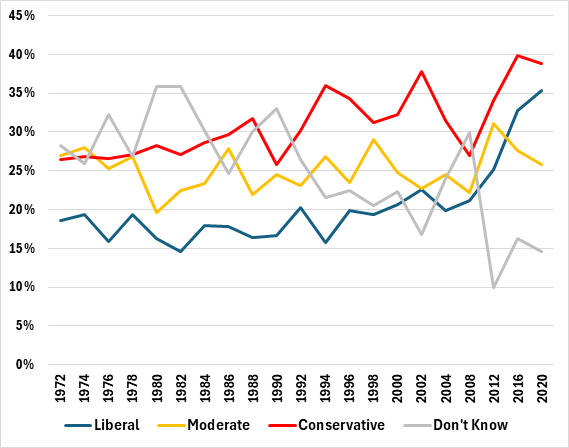 Political polarization has become a feature of the modern American electorate. But it wasn’t always this way. Paul Whiteley looks at what’s been driving polarization in the US, writing that over the last five decades the number of those who ‘don’t know’ if they are liberal, moderate, or conservative has fallen. One potential cause of this trend, he writes, is new generations of voters identifying with a political party and keeping this attachment as they get older. Popular presidents increase support among the young for their party, support which can stay with them as they vote in subsequent elections.
Political polarization has become a feature of the modern American electorate. But it wasn’t always this way. Paul Whiteley looks at what’s been driving polarization in the US, writing that over the last five decades the number of those who ‘don’t know’ if they are liberal, moderate, or conservative has fallen. One potential cause of this trend, he writes, is new generations of voters identifying with a political party and keeping this attachment as they get older. Popular presidents increase support among the young for their party, support which can stay with them as they vote in subsequent elections.
The American electorate has become polarized, but just how polarized, and why has it become this way? Figure 1 shows the extent to which Americans think of themselves as ‘liberals’, ‘moderates’ or ‘conservatives’ in every national election for Congress and the Presidency from 1972 to 2020. It provides a vivid description of the polarization of American politics over time. The data comes from the American National Election study (ANES) which has charted changes in ideological self-identification among American voters over this period of nearly half a century.
Figure 1 – Ideology of Americans in National Elections – 1972 to 2020

Source: American National Election Study
There are some interesting data points in Figure 1. The first is that conservatives have outnumbered liberals in every election since 1972, but the gap between them has narrowed over time. In 1972 19 percent thought of themselves as liberals with 26 percent identifying as conservatives. By 2020 it was 35 percent liberals and 39 percent conservatives.
This change was not produced by a decline in moderates since they made up 27 percent of respondents in 1972 and 26 percent in 2020. Rather it was caused by the decline in the ‘don’t knows’, who made up 28 percent of respondents in 1972, but this had fallen to 15 percent by 2020.
The driver of polarization
This shows that polarization in American politics has been driven by voters adopting an ideological identity for the first time, rather than by liberals switching to become conservatives or moderates (and the other way round). This kind of change is more consistent with cohort rather than life-cycle effects. In the former, new generations of voters first identify with a party and tend to keep this identity as they grow older. In the latter, individuals change their partisan attachments as they get older.
Research shows that when young voters come of age during a successful Presidential term – as defined by a president’s popularity – they are more likely to support the incumbent party, and this stays with them over time. This also works in reverse with a failed presidential term producing a loss of support from newly enfranchised voters which becomes semi-permanent.

“Maryland Grassroots Event with President” (CC BY-NC 2.0) by democratic_flickr
Figure 2 labels the party in the White House since 1972, and it shows how the Democrats have benefited from this effect in recent presidential terms. This has not always been the case though since Democrat Jimmy Carter was an unpopular one-term president elected in 1976 who experienced declining approval ratings over time. In contrast, his successor, Republican Ronald Reagan, had very positive approval ratings, though this changed when he was replaced by Republican George HW Bush in 1988.
Figure 2 – Approval Ratings of Presidential Incumbents 1972-2020

Source: American National Election Study
Bill Clinton was first elected in 1992 and he boosted presidential approval ratings for the Democrats during his two terms of office. However, in 2000 Republican George W Bush took over and thanks to the ill-fated war in Iraq in 2003, and the subsequent financial crash in 2008, his approval ratings fell further than any other president over the whole period.
His successor, Democrat Barack Obama was elected in 2008 and rapidly turned this around building up positive approval ratings, although they did not reach the levels achieved by Bill Clinton. Subsequently when Donald Trump won the presidential election in 2016 things changed again, as his approval ratings rapidly began to fall.
Before Bill Clinton was elected the Republicans benefitted from support from newly enfranchised voters, but after him the Democrats were the beneficiaries. Simply put George Bush senior, junior and Donald Trump were failures in the eyes of new voters and Bill Clinton and Barack Obama were successes.
This can be illustrated by the voting data from the ANES. In 1980, when Ronald Reagan was first elected, 50 percent of 18 to 24-year-olds voted for him and only 35 percent voted for the incumbent, Jimmy Carter. In 2020 when Joe Biden replaced Donald Trump 73 percent of this group voted for Biden and only 25 percent supported Trump. The 2020 contest provided the highest percentage of support for the Democrats among new voters in all the Presidential elections since 1972.
The Implications for Joe Biden
It is well-known that Joe Biden currently has poor approval ratings. According to a poll conducted on April 4th, 39 percent approved of his performance as president and 55 percent disapproved. However, a Gallup poll conducted in March this year showed that 29 percent of respondents thought that neither Biden nor Trump would make a good president, even though Trump was favoured by 35 percent compared with Biden’s 30 percent.
More recently, Donald Trump’s voting intention scores in a head-to-head contest with Joe Biden have plummeted. From October last year he moved well ahead of the President, but this has now changed . He cannot campaign when tied up in court and also his ‘martyrdom mantra’ that the prosecutions are all a plot by the Democrats is wearing thin as the sordid revelations about his private life are revealed.
This means that if Joe Biden was up against everyone’s ideal candidate in the November election he would lose. But he is up against a candidate who lost the popular vote in 2016, lost the election in 2020 and saw several of his endorsed candidates lose in the mid-term elections in 2022 and is currently mired in sleaze. For many Americans Biden is the lesser of two evils.
- Please read our comments policy before commenting.
- Note: This article gives the views of the author, and not the position of USAPP – American Politics and Policy, nor of the London School of Economics.
- Shortened URL for this post: https://wp.me/p3I2YF-dMP






